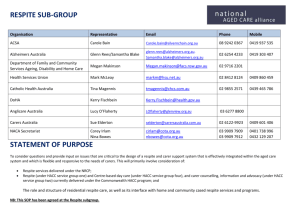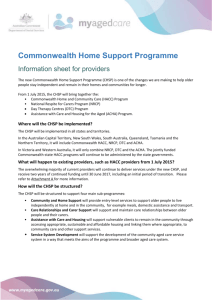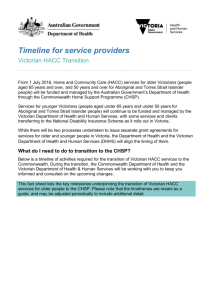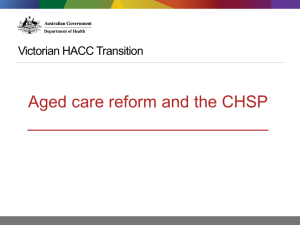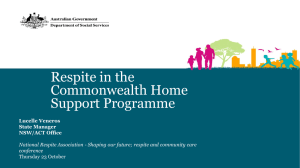Session 4 - Attachment 5 - National Aged Care Alliance
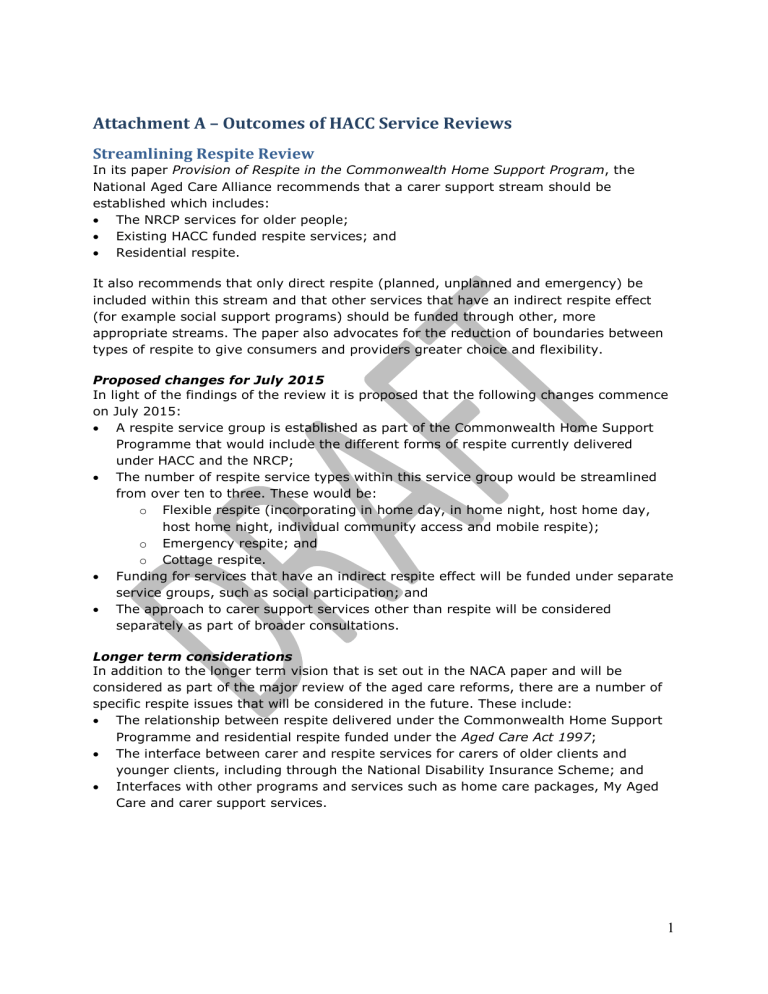
Attachment A – Outcomes of HACC Service Reviews
Streamlining Respite Review
In its paper Provision of Respite in the Commonwealth Home Support Program, the
National Aged Care Alliance recommends that a carer support stream should be established which includes:
The NRCP services for older people;
Existing HACC funded respite services; and
Residential respite.
It also recommends that only direct respite (planned, unplanned and emergency) be included within this stream and that other services that have an indirect respite effect
(for example social support programs) should be funded through other, more appropriate streams. The paper also advocates for the reduction of boundaries between types of respite to give consumers and providers greater choice and flexibility.
Proposed changes for July 2015
In light of the findings of the review it is proposed that the following changes commence on July 2015:
A respite service group is established as part of the Commonwealth Home Support
Programme that would include the different forms of respite currently delivered under HACC and the NRCP;
The number of respite service types within this service group would be streamlined from over ten to three. These would be: o Flexible respite (incorporating in home day, in home night, host home day, host home night, individual community access and mobile respite); o Emergency respite; and o Cottage respite.
Funding for services that have an indirect respite effect will be funded under separate
service groups, such as social participation; and
The approach to carer support services other than respite will be considered separately as part of broader consultations.
Longer term considerations
In addition to the longer term vision that is set out in the NACA paper and will be considered as part of the major review of the aged care reforms, there are a number of specific respite issues that will be considered in the future. These include:
The relationship between respite delivered under the Commonwealth Home Support
Programme and residential respite funded under the Aged Care Act 1997;
The interface between carer and respite services for carers of older clients and younger clients, including through the National Disability Insurance Scheme; and
Interfaces with other programs and services such as home care packages, My Aged
Care and carer support services.
1
Service Group Two Review
The Department, with the support of Australian Healthcare Associates, reviewed activity under HACC Service Group 2. This was carried out in consultation with the Service Group
2 subgroup of the Commonwealth Home Support Advisory Group.
Service Group 2 includes the following Service Types:
Assessment;
Client care coordination;
Case management; and
Counselling/support, information and advocacy for both the carer and the care recipient.
The following sets out the main findings for each of these service types.
Assessment Service Type
Retaining assessment and service coordination services based at the local level is likely to facilitate better access to services.
Assessments should be conducted face to face to provide the most accurate and comprehensive information.
A suitably skilled and qualified workforce is essential to the conduct of holistic and wellness focused assessments.
Client Care Coordination Service Type
Client care coordination is not a stand-alone activity, but a part of the continuum of care for clients accessing the HACC system.
It is the responsibility of all HACC service providers and should be a cornerstone of basic HACC service provision. However, one of the challenges is that it is often being used to ensure clients continue to receive at least the same level of service as they move from HACC to packaged care and/or from one service provider to another.
It is recognised that many of these clients fall outside the eligibility criteria for
HACC services. Consideration will need to be given to how these clients can transition to packaged care or other services that can better meet the client’s needs.
Case Management Service Type
There is considerable overlap between client care coordination and case management service types. Both involve similar functions including care planning and implementation, service coordination, review and reassessment.
The implementation of new home support packages, including lower level packages raises questions about the need / scope of case management in HACC.
Consideration could be given to confining case management in CHSP to short term episodic circumstances.
Counselling/Support, Information and Advocacy Service Types for both the carer and the care recipient
Counselling/support, information and advocacy are all activities intrinsic to day to day HACC service delivery.
2
There is a need to strengthen the definitions and guidelines for counselling to ensure this is being delivered by a qualified counsellor.
Information and support are intrinsic to service delivery and should no longer be funded as discrete activities, but rather considered within the scope of all CHSP service types.
To support an end to end aged care system where clients can consistently access independent advocacy services to meet their needs it the National Aged Care
Advocacy Program will be expanded to provide services for CHSP clients, and that access to such services be made available across the country.
The way in which the review of Service Group 2 will be incorporated in the establishment of the Commonwealth Home Support Programme and longer term considerations is reflected in Section 3 of the Discussion Paper.
Service Group Five Review
The Department, with the support of KPMG, reviewed activity under HACC Service Group
Five. This was carried out in consultation with the Service Group Five Sub Group of the
Commonwealth Home Support Advisory Group.
Service Group Five includes the following Service Types:
Formal Linen Services;
Goods and Equipment;
Home Maintenance; and
Home Modifications.
The following sets out the main findings for each of these service types, including proposed changes for July 2015 and beyond.
Formal Linen Services
The review of Formal Linen Services found that there are a variety of models delivering this service under the Commonwealth HACC Program. This ranges from volunteers stripping and making beds and sending the laundry off site, to purpose built laundries. It provides a valued service for a small number of clients who may be too frail to launder their own linen and/or have a high volume of linen because of incontinence or illness.
The service often supplements domestic assistance or is provided in lieu of domestic assistance if it is the most cost effective use of resources, or if the client’s laundry presents health and safety issues to the worker or volunteer.
Proposed changes for July 2015
In light of the findings of the review it is proposed that the following changes commence from July 2015:
Formal Linen will not be a separate service type in the CHSP. The funding for
Formal Linen Services will, where possible, be amalgamated with a provider’s
funding for domestic assistance.
Where this is not possible, for example where a provider does not offer domestic assistance, the most appropriate option for that provider will be negotiated.
Home maintenance
The review of home maintenance services found that there are inconsistent approaches across the country with regards to client access, assessment, prioritisation and approaches to the payment of fees. The review has also highlighted inequitable delivery
3
of services and workforce issues particularly for rural and remote services. The review suggested the following potential client/carer benefits:
Accessibility: there are links between home maintenance and accessibility, particularly in relation to garden maintenance.
Independence and safety : home maintenance services can act as a preventive measure to reduce the risk of falls through hazard reduction which improves safety within the home and enables independent living.
Health and wellbeing: services which maintain garden and outdoor spaces can reduce anxiety experienced by individuals, increase dignity and pride, and reduce the burden placed on an older individual’s carer.
Proposed changes for July 2015
In light of the findings of the review it is proposed that the following changes commence from July 2015:
That Home Maintenance will be a service type in the CHSP in the Assistance at
Home service group, along with Domestic Assistance
Home maintenance in the CHSP will be focused on those activities that are effective in supporting older people to stay in their homes and maintain their independence.
Service providers who provide services that are primarily aesthetic in nature and are not linked to assessed client need or related to issues of accessibility, safety, independence or health and wellbeing (for example frequent lawn mowing or regular garden pruning) will not be supported.
Longer term considerations
Longer term the provision of home maintenance services will need to consider:
The need for processes which target home maintenance services to older clients
who have the least ability to maintain their homes. The role of fees in achieving this will need consideration.
Delivery of a nationally consistent range/suite of services available from home maintenance services which encompass both minor home repairs and garden maintenance.
Goods and Equipment
The review of Goods and Equipment found that the provision of goods, equipment and assistive technology can contribute to an individual’s ability to remain independent in their home and in the community. It also found:
older people need a range of items, from smaller inexpensive ‘off the shelf’ items to larger expensive items and customised equipment and technology which requires assessment and prescription by professionals with specialised skills and knowledge;
funds currently allocated to Goods and Equipment services under the
Commonwealth HACC program form a very small proportion of government funds for goods and equipment compared with state and territory programs;
the majority of assistive equipment and technology is purchased by the individual and their families;
access to informed, independent information on the types of equipment available, and which equipment best meets their needs, is a very important part of the service delivery system; and
4
client outcomes are better when the goods and equipment are provided as part of overall service provision and accompanied by training and support in using the equipment.
Proposed changes for July 2015
In light of the findings of the review it is proposed that the following changes commence on July 2015:
Goods and Equipment will be a service type in the CHSP in the Increased
Independence group.
Providers can purchase or loan items, up to the value of $500 per year per person, for clients who are unable to purchase the item/s independently.
Organisations such as the Independent Living Centres will be positioned provide information and assessment for clients as well as to support the sector delivering equipment and assistive technology services.
Providers of other service types, such as respite care, personal care or domestic assistance, can use a small proportion of their funds for that service type to purchase an item for the client if it contributes to the independence of the person, it is the client’s choice, and if it is the most effective and efficient way to deliver the service.
Longer term considerations
Concurrent with the reforms to aged care are the reforms for disability services, including the roll out of the National Disability Insurance Scheme. Any long term changes to goods and equipment programs for older people will need to take into account the work that is currently being undertaken by the National Disability Insurance Agency which will make recommendations on the future of goods and equipment and assistive technology provision across Australia.
Other considerations include the interface between the Home Care Program and goods and equipment schemes, and the role of specialised assessment for goods and equipment in the context of My Aged Care assessment.
Home modifications
The review of home modification services found that there are inconsistent approaches across the country with regards to client access, assessment, prioritisation and approaches to the payment of fees. The review has also highlighted inequitable delivery of services across the country, within and between regions and workforce issues related to access to Occupational Therapists, Licenced Builders, and other licensed tradespersons. Further, that these issues were more pronounced for rural and remote services. The review findings support evidence that home modifications can have positive outcomes for individuals and may reduce the need for downstream care. The likelihood of positive outcomes increased where modifications are not provided in isolation, but instead form part of a holistic, reablement focussed approach.
Key benefits associated with home modifications were:
Accessibility: targeted home modification enhances accessibility within the home, as well as improved access to the broader community and participation in outdoor activities.
5
Independence: home modification can have a positive impact on independence and engaging in activities of daily living, for individuals and carers. Home modifications have been linked to a reduced rate of functional decline in older people and can slow the impact of age related disability.
Safety: the installation of home modifications can result in improved safety, particularly as it relates to risk for falls.
Health and wellbeing: Individuals whose homes were more conducive to functional capacity following the installation of home modifications can experience a positive impact on their physical and mental health.
HACC MDS data indicates that over 90 per cent of HACC home modifications instances of expenditure undertaken in 2012-13 had a Commonwealth contribution of below $1,000.
A total of 98 per cent of modifications had a Commonwealth contribution of below
$10,000. HACC MDS data does not currently provide information on the types of modifications undertaken.
Proposed changes for July 2015
In light of the findings of the review it is proposed that the following changes commence from July 2015:
That home modifications will be a service type in the CHSP in the Health and
Functioning service group, along with Allied Health and Goods and Equipment.
That consistent with the basic tier of support in the Commonwealth Home
Support Programme, the home modifications supported focus on simple, lower cost modifications (with the vast majority being under $1,000 for individual instances of Commonwealth expenditure), with scope to undertake some more complex higher cost modifications (up to $10,000 of CHSP expenditure.
That the assessment process for receiving home modifications is inclusive of access to specialised input, such as completion of a functional assessment of the client by an Occupational Therapists. That clinical assessment and recommendations support client outcomes such as improvements in client function, increased client independence and possibly reduces the need for other services.
That the CHSP does not add extra requirements on top of existing state and territory regulation of who can undertake various home modifications.
That the fees policy for the CHSP takes into account the specific factors associated with the provision of home modifications (with most clients historically contributing a significant proportion towards the modification).
Longer term considerations
Longer term considerations for the home modification service type include:
Information and awareness: through the provision of information to assist clients to relocate and downsize housing as an alternative to major modifications; and
Increased emphasis on forward planning: through the promotion of universal design principles to reduce or remove the need for substantial modifications into the future.
Client reviews post modification: review forms a component of the assessment process where complex/higher cost modifications are recommended.
6
Service Group Six Review
The Australian Institute of Primary Care and Ageing (La Trobe University) was contracted to support the review of Meal Services (HACC Service Group 6 in addition to Other Food
Services from Service Group 1 and allied health services from Service Group 3 as they relate to meal services), with advice from the Meals Review Sub-Group of the
Commonwealth Home Support Programme Advisory Group.
The following sets out the main findings from the review, including proposed changes for
July 2015:
Meals, Other Food services and allied health play a key role in supporting older people to remain living at home through providing nutritious meals, advice on dietary requirements, connection with the community, informal health monitoring of clients and activities to support independence.
The delivery of this highly valued support has evolved over time to remain responsive to local conditions, capacity and clients. Models are diverse, flexible, sometimes innovative and often driven by a substantial volunteer base working to create local solutions to meet individual client needs.
These needs too are evolving and becoming increasingly challenging for providers to meet. For example, clients are seeking services that respond to cultural diversity; offer choice and variety; are tailored to health conditions and dietary requirements; fulfil social needs; support wellness where possible; and prioritise nutrition.
For many clients, meals delivered at centres or at home are the 'main meal of the day', so nutrition content is important. However, the review found that a wide range of nutrition guidelines operate across jurisdictions; nutrition risk screening could be more consistent; and provider access to allied health professionals such as dietitians is limited.
The following options for meal services under the Commonwealth Home Support
Programme recognise the diversity of client need; promote consistency alongside flexibility; and support sector development and capacity.
Proposed changes for July 2015
In light of the findings of the review, the following changes are proposed for July 2015:
Nutrition risk screening will be included under the Aged Care Gateway o Clients identified as requiring meal services will be screened for nutrition risk by the Aged Care Gateway to ensure appropriate services are delivered to meet nutritional outcomes. Should a client be identified as at risk of malnutrition through screening, they will be referred to the Aged Care
Gateway face-to-face assessment services for a detailed nutrition assessment,
support plan and referral to appropriate services.
Include Other Food Services (OFS) as part of an independence / wellness approach. o OFS include assistance with preparing meals at home and advice on nutrition.
This is a growing service area and can contribute to a client's independence and self-care. These services will be offered under the Commonwealth Home
Support Programme's broader approach to promoting independence within the
Increased Independence group.
7
Longer term considerations
Develop voluntary National Nutrition Guidelines for delivered and centre-based meals (based on existing state guidelines). o These guidelines will be developed from July 2015 to provide nationally consistent, practical advice to meal providers to support their existing efforts in enhancing the nutritional quality of meals and responding to nutrient requirements for frail aged clients in particular.
Explore options for improving access to allied health professionals across all jurisdictions. o Mapping of the workforce will be undertaken from July 2015 to inform future options for improving access to these services.
Improving integration between services types (eg meals and community transport) and encouraging partnerships that assist providers to support clients with special needs.
Service Group Seven Review
Verso Consulting was contracted to undertake a review of HACC Service Group 7
(Transport also known as Community Transport), in consultation with the Transport
Review Sub-group of the Commonwealth Home Support Programme Advisory Group.
The review found that there is an increasing demand for community transport driven by a range of factors, including an ageing population (especially people aged 85 years and over) and their increasing support needs, the prevalence and impact of dementia, the high demand for health services, and reduced access to carers.
More specifically, the review found that:
the current delivery of community transport services is complex and fragmented.
There is not a single service model across Australia. Transport providers deliver services to both younger and older clients, and operate across a range of service delivery systems funded by local communities and different levels of government.
there is a mix of directly funded transport services and "embedded" transport
(where transport is an enabler of other service types or programs, but not separately reported on or funded, e.g. Social Support, Respite, Centre-Based Day
Care. There is also a significant amount of community transport provided through
Commonwealth-funded Home Care Packages and DVA programs. the volunteer workforce is an integral component of the community transport system and needs to be actively supported.
there is a high demand for non-emergency medical transport, which is limiting the availability of transport to support activities of daily living, e.g. participation in community activities, social events, shopping, banking, etc.
transport for non-emergency medical purposes (eg outpatient services such as oncology, renal dialysis and other hospital based treatments) should be outside the scope of the Commonwealth Home Support Programme. There will need to be further consultation between the Commonwealth and state governments on roles and responsibilities before changes are implemented in this area. These discussions should occur prior to the commencement of the CHSP, but changes may not be introduced for July 2015.
the current funding model for community transport under the Commonwealth
HACC Program needs to be reviewed. A future funding model should take into account a range of factors, including trips of varying lengths, the different costs
8
of providing services in some areas (particularly rural and remote Australia), the relationship between the client and the carer, how capital assets and replacement of vehicles are funded, and client fees.
a significant part of the community transport sector is characterised by small organisations with part-time administration and volunteers (particularly as drivers). As a result, introducing change will be difficult and should be done incrementally.
Proposed changes for July 2015
In light of the findings of the review, the following changes are proposed for July 2015:
A definition of “Commonwealth Home Support Programme Transport” will be developed over the coming months and included in the programme manual. o The definition will include the type of services (trip purposes) that are supported by the new Programme, with a proposed focus on social contact and support activities (including religious and cultural events), local health appointments (eg GP, allied health, dentist), and activities of daily living (eg shopping and banking).
The Department will work closely with the Australian Community Transport
Association, relevant state and territory bodies, and service providers to explore ways in which the transport sector can be supported through the CHSP - particularly in areas such as improving co-ordination and networking of transport
services, supporting volunteers, maximising opportunities for flexibility in service delivery, and minimising red tape.
A national fee policy for the CHSP will be introduced from July 2015.
Development work (to be undertaken during 2014) will consider the implications of the introduction of the fees policy on transport service providers and clients.
Longer term considerations
Review of the current funding models, including whether Commonwealth Home
Support Programme transport be funded on the basis of distance travelled
(kilometres or a range of kilometres) per client, development of a schedule/table of unit prices for transport and consideration of how capital costs and replacement of assets are funded under the Commonwealth Home Support
Programme. o To support this work, the review recommended the collection of additional data from service providers (eg from July 2015), with a new funding model to be introduced in the next funding period, eg from 2018.
o The Department agrees in-principle to further work in this area. There will be further discussions with stakeholders on how and when this work is undertaken.
Development of strategies to promote transport independence o The Department will work with stakeholders to explore opportunities for innovative programs aimed at promoting transport independence, either within the Commonwealth Home Support Programme or in other transport programmes.
9
